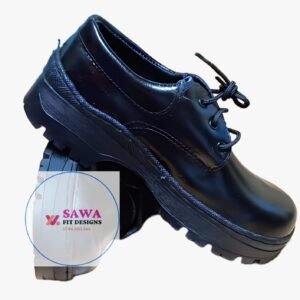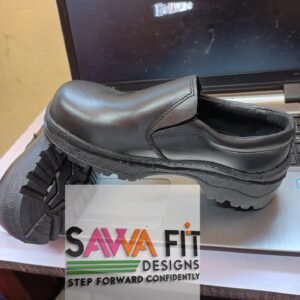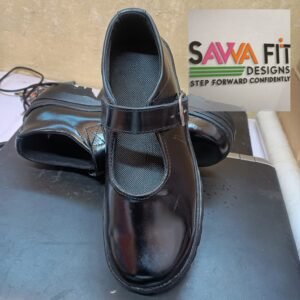Features of a Good School Shoe
Discover what makes Kenyan school shoes like SawaFit stand out—durability, comfort, and smart design for active students. Expert buying guide for parents.
-
Back to School Shoes -Genuine Pure Leather
Original price was: KSh1,300.KSh1,000Current price is: KSh1,000.Select options This product has multiple variants. The options may be chosen on the product pageClear3234242526272829303133 -
Boys Black School Shoes
Original price was: KSh1,500.KSh1,200Current price is: KSh1,200.Select options This product has multiple variants. The options may be chosen on the product pageClear363835373940 -
Slip-On School Shoes Boys
Original price was: KSh2,500.KSh2,000Current price is: KSh2,000.Select options This product has multiple variants. The options may be chosen on the product pageClear323436382728293031333537 -
Girls School Shoes (Buckle)
Original price was: KSh1,800.KSh1,400Current price is: KSh1,400.Select options This product has multiple variants. The options may be chosen on the product pageClear3837
What Makes a Good School Shoe? A Kenyan Parent’s Guide
Choosing the right school shoes in Kenya isn’t just about looks—it’s about finding footwear that supports your child’s daily activities while offering value for money. With brands like SawaFit dominating the market, parents have access to options that blend durability, comfort, and style. Here’s how to identify a good school shoe and why Kenyan families increasingly trust local brands.
The Foundations of Quality School Footwear
A good school shoe balances several factors to meet the demands of Kenya’s active students. From navigating muddy paths during rainy seasons to enduring hours of classroom wear, the right pair can make a tangible difference in a child’s school experience.
Durability: Built to Last
Kenyan school shoes face tough conditions, making durability a top priority. Brands like SawaFit use full-grain leather uppers and reinforced stitching to withstand scuffs, scrapes, and frequent use. The soles matter just as much—thick rubber outsoles with deep treads provide grip on uneven surfaces and resist wear from daily commutes. Look for shoes that maintain their shape after months of use, as noted in parent reviews praising SawaFit’s ability to last entire academic years.
Comfort: Supporting Growing Feet
Children spend 6-8 hours daily in school shoes, making comfort non-negotiable. Key features include:
- Cushioned insoles that absorb impact during playtime
- Breathable linings to prevent sweat buildup in Kenya’s tropical climate
- Flexible soles that bend naturally with the foot’s movement
SawaFit incorporates memory foam footbeds in many designs, a feature parents highlight for reducing foot fatigue. Their buckle-fastened models also allow adjustable tightness, accommodating different foot widths.
Safety and Fit: Often Overlooked Essentials
Secure Fastenings for Active Kids
Velcro straps and buckles dominate Kenya’s school shoe market for good reason—they stay secured during running and jumping. Slip-on styles, while convenient, often lack the ankle support needed for younger children. SawaFit’s buckle designs strike a balance, offering easy adjustability without compromising stability.
The Right Fit Matters More Than You Think
Ill-fitting shoes can cause blisters, ingrown nails, or long-term posture issues. Kenyan parents should:
- Measure both feet (sizes can differ slightly)
- Leave a thumb’s width of space at the toe for growth
- Check heel slippage—more than 5mm can lead to chafing
SawaFit’s size range (27-45) accommodates preschoolers to teenagers, with half-sizes available for precise fits. Their online guides help parents measure accurately, reducing returns.
Style Within School Guidelines
While most Kenyan schools mandate black leather shoes, brands innovate within these constraints. SawaFit offers:
- Textured finishes (matte vs glossy) for subtle variety
- Contrast stitching details on select models
- Streamlined profiles that appeal to older students
Teenagers particularly appreciate designs that mimic adult formal shoes, fostering a sense of maturity. For girls, slightly tapered toe boxes provide a feminine touch without breaking uniform rules.
Affordability Without Compromise
Kenyan families often budget carefully for school supplies. A good school shoe should:
- Cost between KSh 1,000–2,000 (SawaFit’s mid-range pricing falls here14)
- Offer replacement guarantees for manufacturing defects
- Require minimal maintenance (a wipe-clean surface saves time)
Parents note that while initial costs might be higher than imported alternatives, local brands like SawaFit prove cheaper long-term due to their durability.
Why SawaFit Leads Kenya’s School Shoe Market
Designed for Local Conditions
SawaFit’s shoes address Kenya-specific challenges:
- Water-resistant leather handles rainy seasons
- Deep tread patterns grip muddy walkways
- Reinforced toe caps protect against rocky paths
Their manufacturing process uses locally sourced materials where possible, keeping prices competitive.
Parent-Approved Performance
Common praises in customer reviews include:
- “My Class 3 son’s shoes still look new after Term 3”
- “No more blisters during sports days”
- “Easy to clean with a damp cloth”
Accessibility Across Kenya
Available through:
- SawaFit’s website with nationwide delivery
- Retail partners in major towns
- E-commerce platforms like Jiji.co.ke for last-minute purchases6
Smart Shopping Tips for Kenyan Parents
- Buy Early: Avoid the January rush and secure correct sizes.
- Prioritize Replaceable Insoles: Lets you refresh cushioning annually.
- Check Return Policies: Especially when buying online.
- Involve Your Child: Comfort depends on their feedback during fitting.
The Verdict on Quality School Shoes
A good school shoe in Kenya isn’t a luxury—it’s a practical tool for education. By focusing on durable materials, ergonomic design, and local affordability, brands like SawaFit demonstrate that quality footwear can be both accessible and long-lasting. As you prepare for the next school year, remember: the right pair protects your child’s feet today and saves money tomorrow.
-
Back to School Shoes -Genuine Pure Leather
Original price was: KSh1,300.KSh1,000Current price is: KSh1,000.Select options This product has multiple variants. The options may be chosen on the product pageClear3234242526272829303133 -
Boys Black School Shoes
Original price was: KSh1,500.KSh1,200Current price is: KSh1,200.Select options This product has multiple variants. The options may be chosen on the product pageClear363835373940 -
Slip-On School Shoes Boys
Original price was: KSh2,500.KSh2,000Current price is: KSh2,000.Select options This product has multiple variants. The options may be chosen on the product pageClear323436382728293031333537 -
Girls School Shoes (Buckle)
Original price was: KSh1,800.KSh1,400Current price is: KSh1,400.Select options This product has multiple variants. The options may be chosen on the product pageClear3837



